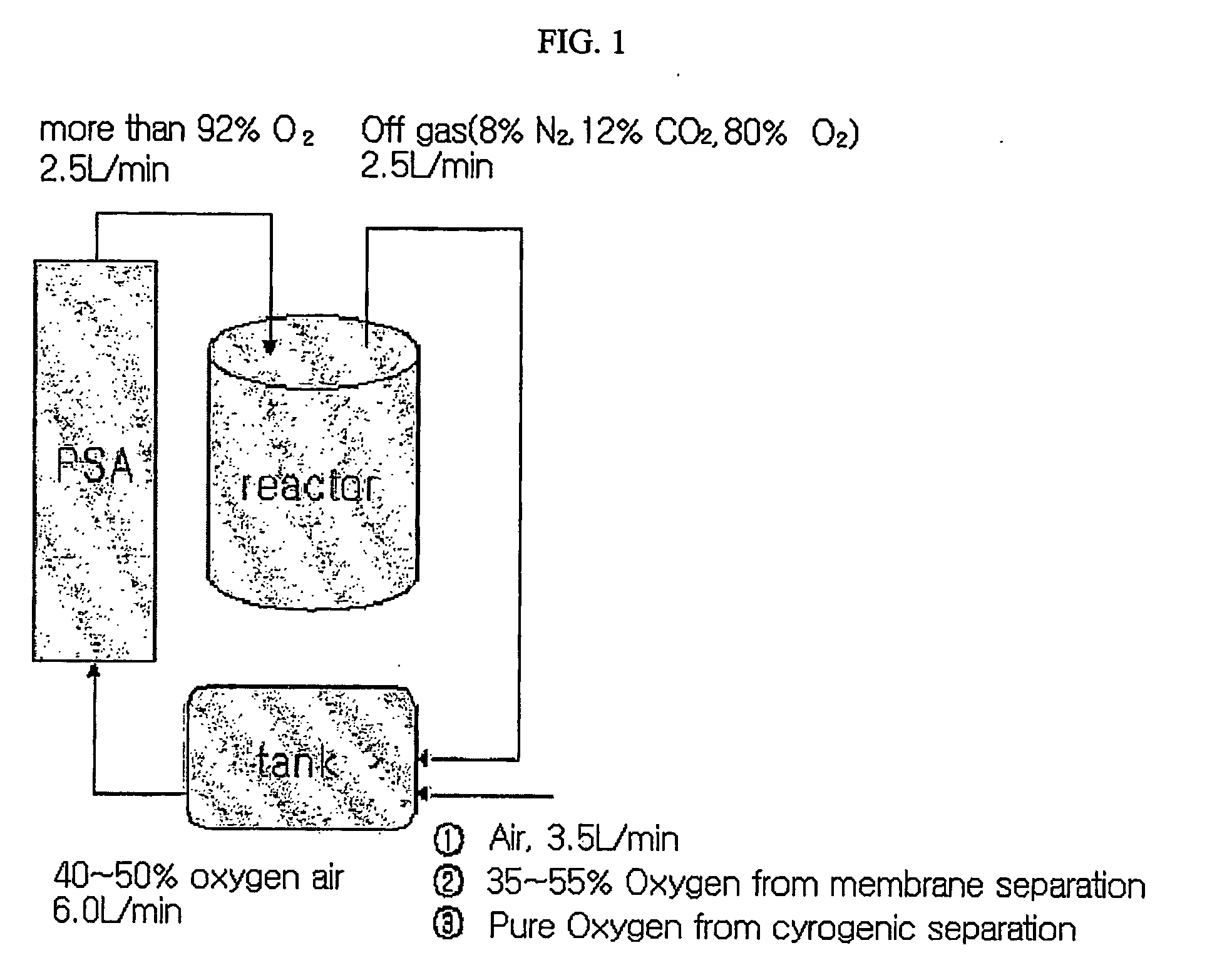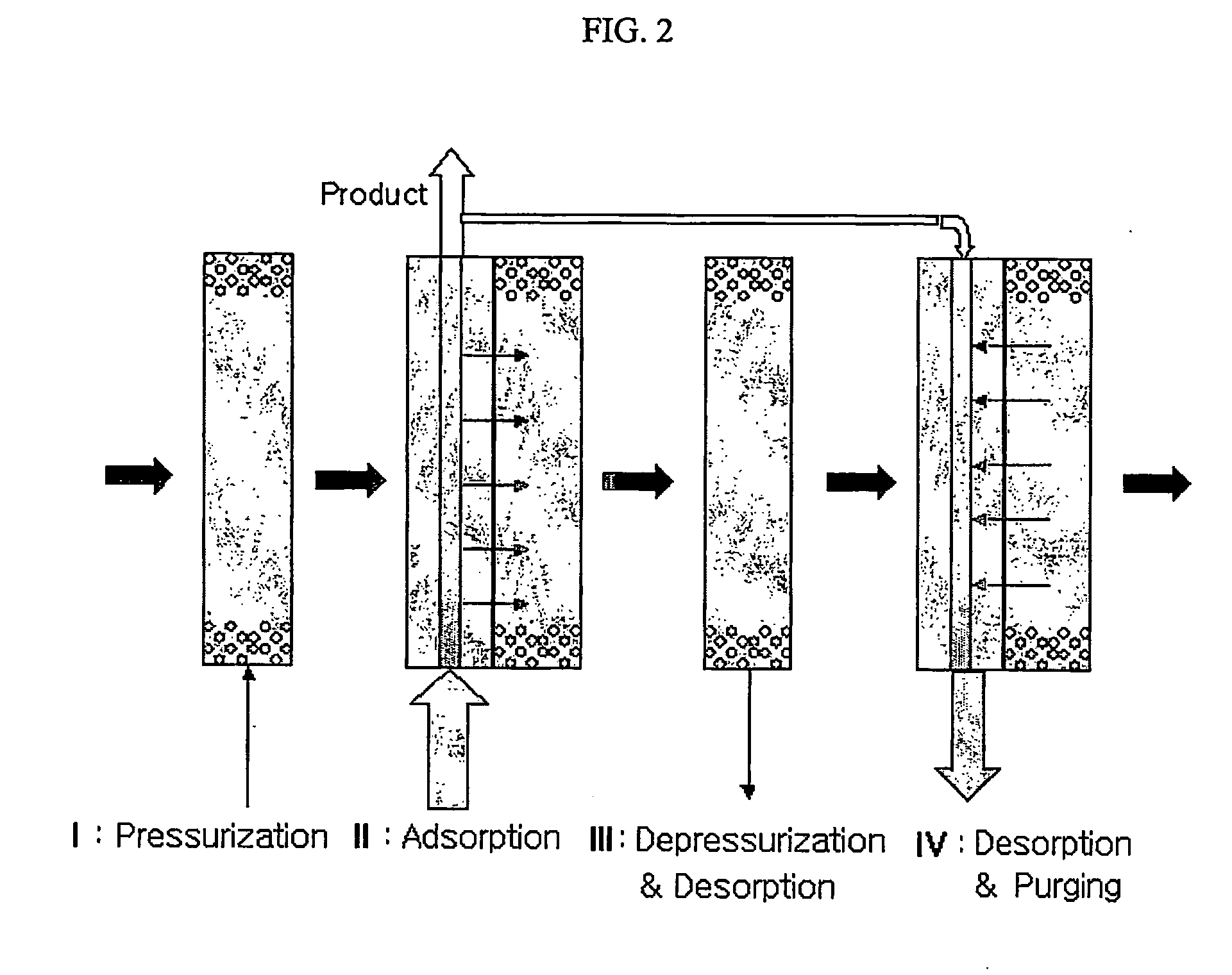Method for producing a useful compound and treating a wastewater using pure oxygen
a technology of pure oxygen and compound, which is applied in the direction of oxygen/ozone/oxide/hydroxide, sustainable biological treatment, separation processes, etc., can solve the problems of limited use of pure oxygen in the laboratory setting, hindering the growth or desired metabolism of cells, and reducing the size of adsorption columns, so as to reduce equipment, facilities and operation of the psa system. , the effect of increasing the productivity of the fermentation process
- Summary
- Abstract
- Description
- Claims
- Application Information
AI Technical Summary
Benefits of technology
Problems solved by technology
Method used
Image
Examples
example 1
Continuous Process Operation of PSA System
[0029] Although a PSA system can comprises two to several adsorption columns, FIG. 2 shows a PSA operation process of two adsorption columns (bed 1A and bed 1B). First, processes operating in one adsorption column are divided into a pressurization process (I), an adsorption process (II), a depressurization and desorption process (III), and a desorption and purging process (IV).
[0030] In step 1, the bed 1A is in the depressurization and desorption process, and the bed 1B is in the adsorption process. The step 1 has an operation time of 9 seconds and thus is a process requiring a relatively long time. In step 2, the beds 1A and 1B are subjected to pressure equilibrium for 2 seconds, and then in step 3, the bed 1A is subjected to the pressurization process (I) for one second, followed by the adsorption process (II) for 29 seconds in steps 4-6. In step 7, the bed 1A is subjected to equilibrium for 2 seconds, followed by the depressurization an...
example 2
Production of Pure Oxygen Using Air as Feed Gas
[0033] As the beds 1A and 1B, columns each having a diameter of 5 cm and a height of 57 cm were filled with alumina (D-201) and zeolite (CECA-CO2 Li—X), and a vacuum pump (Hitachi, YEFO-KTPM) and an air compressor (KNF Neuberger, N811KN, 18) were used to construct a PSA system which can sufficiently realize the cycle time given in Table 3.
[0034]FIG. 3 shows feed flow rate (▪) and product flow rate (♦) when air was used as feed gas for a PSA column. In this case, a cycle time (sec) of 9-2-1-10-10-9-2-1-10-10 was used. When the feed flow rate of air was 15 L / min and adsorption pressure was elevated to 3,000 mmHg, O2 with a purity of more than 92% could be obtained as much as 2.45 L / min (see FIG. 3). And, the recovery of oxygen from air was 71.5% [=(2.45×0.92) / (15×0.21)].
example 3
Production of Pure Oxygen by PSA Process Using Off-Gas / Air Mixture with Oxygen Concentration of 40%
[0035] In this Example, the PSA system constructed in Example 2, a gas mixture (with O2 content of 40%) which can be used in a fermentation process, and a cycle time (second) of 15-2-1-10-10-15-2-1-10-10 was used. Adsorption time was 36 sec, desorption time was 36 sec, and each equilibrium time was 2 sec. Flow rate and pressure are shown in FIG. 4. As shown in FIG. 4, when the flow rate of the mixed gas with an O2 concentration of 40% was 6.7 L / min and adsorption pressure was elevated to 1,000 mmHg, O2 with a purity of more than 92% could be produced as much as 2.44 L / min. And, the recovery of oxygen was 83.5% [=(2.44×0.92) / (6.7×0.4)].
[0036] Table 4 below shows the comparison of efficiency between the use of a gas mixture from recycled off-gas / air as feed gas to the PSA system and the use of air alone. When the mixed gas with an O2 concentration of 40% was used as feed gas, the flow ...
PUM
 Login to View More
Login to View More Abstract
Description
Claims
Application Information
 Login to View More
Login to View More - R&D
- Intellectual Property
- Life Sciences
- Materials
- Tech Scout
- Unparalleled Data Quality
- Higher Quality Content
- 60% Fewer Hallucinations
Browse by: Latest US Patents, China's latest patents, Technical Efficacy Thesaurus, Application Domain, Technology Topic, Popular Technical Reports.
© 2025 PatSnap. All rights reserved.Legal|Privacy policy|Modern Slavery Act Transparency Statement|Sitemap|About US| Contact US: help@patsnap.com



